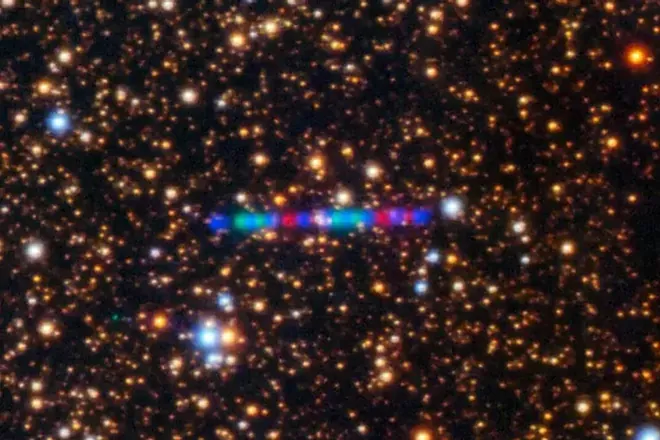A new cosmic visitor captured the attention of astronomers and the public alike: 3I/ATLAS, an interstellar comet speeding through our solar system. Sensational headlines have claimed it’s a “Manhattan-sized” object that could strike Earth in November 2025, possibly even an alien spacecraft. But what’s the real story?

Discovery of 3I/ATLAS
On July 1, 2025, the NASA-funded ATLAS (Asteroid Terrestrial-impact Last Alert System) telescope in Rio Hurtado, Chile, first spotted an unusual object. Initially labeled A11pl3Z, it was quickly identified as an interstellar object due to its hyperbolic trajectory—a path that doesn’t orbit the Sun like objects in our solar system. On July 2, 2025, the Minor Planet Center confirmed its interstellar nature and named it 3I/ATLAS, marking it as the third known interstellar object after ‘Oumuamua (2017) and 2I/Borisov (2019). It was also designated C/2025 N1 (ATLAS), reflecting its cometary nature.
Follow-up observations from telescopes like the Zwicky Transient Facility in California and contributions from amateur astronomers helped confirm its path. The comet’s discovery was challenging because it approached from the direction of the Galactic Center’s dense star fields, making it hard to spot earlier.
Key Details of 3I/ATLAS Discovery
| Aspect | Details |
|---|---|
| Discovery Date | July 1, 2025 |
| Discovered By | ATLAS telescope, Rio Hurtado, Chile |
| Initial Designation | A11pl3Z |
| Official Name | 3I/ATLAS (C/2025 N1) |
| Interstellar Status | Third known interstellar object, confirmed by Minor Planet Center |
| Source | NASA Science |
Characteristics of 3I/ATLAS
3I/ATLAS is a fascinating object with distinct features that set it apart:
- Size: Estimates suggest it’s 10-20 kilometers (6-12 miles) in diameter, making it larger than the previous interstellar objects (‘Oumuamua was about 100 meters, and 2I/Borisov was less than 1 km). However, claims of it being “Manhattan-sized” are misleading, as Manhattan’s area is about 59 square kilometers, far larger than the comet’s estimated size.
- Speed and Trajectory: Traveling at over 60 km/s (approximately 134,000 mph), 3I/ATLAS follows a highly hyperbolic orbit with an eccentricity of 6.2, meaning it’s not bound to our solar system. It will reach its closest point to the Sun (perihelion) on October 30, 2025, at 1.4 astronomical units (au), or about 130 million miles (210 million km), just inside Mars’ orbit. Its closest approach to Earth will be on December 19, 2025, at 167 million miles (270 million km).
- Cometary Features: Unlike ‘Oumuamua, which lacked clear cometary activity, 3I/ATLAS shows a coma (a cloud of gas and dust) and a tail, typical of comets as they heat up near the Sun. This confirms its classification as a comet.
- Age and Origin: Researchers, such as Matthew Hopkins from the University of Oxford, suggest 3I/ATLAS could be over 7 billion years old, predating our solar system by more than 3 billion years. It likely originated from the Milky Way’s “thick disk,” a region of ancient stars, and arrived from the direction of the constellation Sagittarius.
3I/ATLAS Characteristics
| Feature | Details |
|---|---|
| Size | 10-20 km (6-12 miles) in diameter |
| Speed | Over 60 km/s (134,000 mph) |
| Orbit | Hyperbolic, eccentricity 6.2 |
| Perihelion | October 30, 2025, at 1.4 au (130 million miles) |
| Closest to Earth | December 19, 2025, at 167 million miles (270 million km) |
| Cometary Activity | Shows coma and tail, confirming comet classification |
| Age | Potentially over 7 billion years old |
| Source | Space.com |
NASA and Scientific Consensus: No Threat to Earth
NASA and the global astronomical community have been clear: 3I/ATLAS poses no threat to Earth. Here’s why:
- Safe Distance: At its closest, 3I/ATLAS will be 167 million miles (270 million km) from Earth, more than 1.6 times the distance from Earth to the Sun. This is far too distant for any impact risk.
- Well-Understood Trajectory: The comet’s path is well-documented, with no indication of deviation toward Earth. It will pass closest to Mars on October 2, 2025, at 18 million miles (30 million km), and remain safely distant from all planets.
- Natural Behavior: The presence of a coma and tail, along with its hyperbolic orbit, aligns with the characteristics of a natural comet. There’s no evidence suggesting it’s anything other than a celestial body from another star system.
The European Space Agency (ESA) and other observatories worldwide, including the Virtual Telescope Project, have also tracked 3I/ATLAS, reinforcing NASA’s findings. ESA’s Planetary Defence Office has confirmed its safe passage.
Tres científicos, liderados por Avi Loeb, advierten que el objeto interestelar 3I/ATLAS podría ser una nave espacial con intenciones hostiles.
— Exploración OVNI (@exploracionovni) July 27, 2025
Denominado como "3I/ATLAS", el objeto interestelar fue descubierto el 1 de julio, lanzándose hacia el sol a más de 210.000 km/h. Menos… pic.twitter.com/3lZMUzZnxl
Controversial Claims: Is 3I/ATLAS Alien Technology?
Despite the scientific consensus, some have speculated that 3I/ATLAS could be an alien artifact. These claims, primarily from astronomer Avi Loeb and his colleagues, are based on a non-peer-reviewed paper and have sparked debate. Here’s a closer look:
- Size Anomaly: Loeb notes that 3I/ATLAS’s brightness suggests a diameter of about 20 km, which is unusually large for an interstellar object. He argues that if it were natural, we should have detected many smaller objects first, based on solar system asteroid statistics.
- Orbital Alignment: The comet’s retrograde orbit is within 5 degrees of Earth’s ecliptic plane, with a 0.2% chance of occurring randomly. This alignment could theoretically make it easier for a spacecraft to approach Earth.
- Lack of Cometary Gas: Early observations showed no clear spectral features of cometary gas, though later data indicated reddening, possibly from the surface. This led to speculation about a non-natural origin.
- Planetary Close Approaches: 3I/ATLAS will pass relatively close to Venus (0.65 au), Mars (0.19 au), and Jupiter (0.36 au), with a cumulative probability of 0.005% for such alignments.
- Reverse Solar Oberth Maneuver: Loeb suggests that if 3I/ATLAS were a spacecraft, it could use the Sun’s gravity at perihelion to slow down and remain in the solar system, a maneuver obscured by the Sun from Earth’s view.
- Timing and Detection: The comet entered the solar system’s outer boundary about 8,000 years ago, coinciding with early human technological records. Its approach from the bright Milky Way center made early detection difficult.
Loeb’s paper is described as a pedagogical exercise, and he acknowledges that 3I/ATLAS is most likely a natural comet. However, he argues that the possibility of it being a technological artifact warrants investigation, given the potential implications. The scientific community, however, remains skeptical, emphasizing the comet’s natural characteristics and the lack of evidence for artificiality. Avi Loeb’s Medium Article provides more details on these claims.
Scientific Significance of 3I/ATLAS
3I/ATLAS is a scientific treasure, offering a rare glimpse into the universe beyond our solar system. Here’s why it’s so exciting:
- Ancient Origins: Potentially over 7 billion years old, 3I/ATLAS could be the oldest comet ever observed, predating our solar system. This makes it a time capsule from another star system.
- Chemical Insights: By analyzing its coma and tail, scientists can study the chemical composition of material from another star system, shedding light on how planets and stars form elsewhere.
- Observational Opportunities: The comet is currently visible in the constellation Sagittarius at a magnitude of 18.5, requiring powerful telescopes. By December 2025, it may brighten to magnitude 11, making it accessible to advanced amateur astronomers. Observatories worldwide are tracking it to gather data before it exits our solar system.
- Future Discoveries: The Vera C. Rubin Observatory, set to begin operations soon, is expected to detect up to seven interstellar objects per year, making 3I/ATLAS a pioneer in this field. Space.com highlights its significance.
Unfortunately, 3I/ATLAS’s high speed (up to 152,000 mph at perihelion) makes it impossible to intercept with current spacecraft technology. The ESA’s Comet Interceptor, planned for launch in 2029, may not be able to catch up either.
Combating Misinformation
The story of 3I/ATLAS underscores the importance of relying on credible sources. Sensational claims, like those suggesting a “hostile alien spacecraft” or an imminent Earth impact, have appeared in some media outlets and social media posts, such as one from @RT_com on X, citing a New York Post article. These claims often misrepresent the science, causing unnecessary fear. Always turn to authoritative sources like NASA, ESA, or peer-reviewed journals for accurate information. NASA’s Official Statement is a reliable starting point.
3I/ATLAS is a remarkable interstellar comet, not a threat to Earth. Its safe passage at 167 million miles in December 2025 dispels fears of a collision, and its natural cometary features counter speculative claims of alien technology. As scientists study this ancient visitor, we gain valuable insights into the universe’s vast history. Let’s celebrate 3I/ATLAS for what it is: a cosmic traveler offering a window into the stars, not a cause for alarm.






